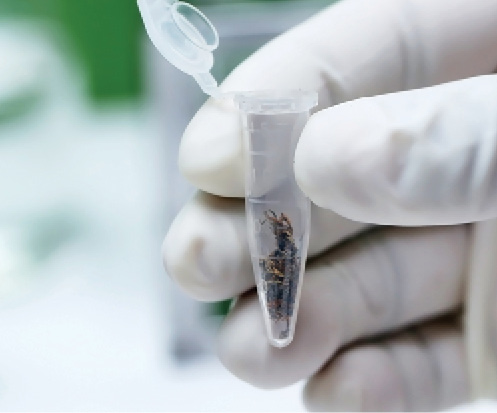TRENDS IN YOUR INBOX: The ABCs of CBD—What to Know Now, What to Do, What Comes Next

 by Roxanne Hawn
by Roxanne Hawn
THE MOST IMPORTANT THING TO KNOW ABOUT CANNABIS in veterinary medicine is that things continue to change. By waiting for a definitive decree from national or state organizations or accepting prior statements as final, veterinarians may find themselves far behind in their knowledge of how cannabis-derived products such as cannabidiol (CBD) affect patients’ lives. Saying nothing may no longer be viable.
Think of it as a mission to Mars. While the veterinary rocket sits idle, with researchers racing to publish species-specific data, others have already launched countless rockets—taking veterinary clients and patients along for the ride.
According to Packaged Facts’ Pet Supplements in the US, Seventh Edition, “It would be difficult to point to an ingredient that has impacted the pet supplements market as quickly and thoroughly as CBD has in the past two years.”
The supplements report says that the pet CBD retail market is estimated at $20 million as of April 2019. Packaged Facts’ consumer survey data shows that 39% of dog owners and 34% of cat owners like the idea of CBD for their pets. In a survey published in the Journal of the American Holistic Veterinary Medical Association in 2018, 79.8% of respondents reported buying hemp or marijuana products for their dogs.
In 2019, Frontiers in Veterinary Science published survey results of US veterinarians’ knowledge, experience, and perception of CBD use in dogs:
- Of those surveyed, 61.5% felt comfortable discussing CBD use with veterinary colleagues
- Of those surveyed, 45.5% felt comfortable discussing it with clients
The authors also reported, “For both veterinary state organizations and state veterinary boards, few participants reported feeling that these entities provided sufficient guidance regarding the use of CBD/marijuana in animals for them to practice within the state or federal law.”
2018 Farm Bill
The Agriculture Improvement Act of 2018 removed hemp and its derivatives from the Controlled Substances Act. However, it did not change the authority of the Food and Drug Administration (FDA) to regulate cannabis or cannabis-derived compounds such as CBD.
Hemp is a type of cannabis. Marijuana is also a type of cannabis, but plant species no longer relate to legal status. Focus instead on the plants’ biochemical/pharmacological characteristics.
To that end, hemp is now defined as cannabis (Cannabis sativa L.) with less than 0.3%, on a dry weight basis, of THC (delta-9-tetrahydrocannabinol)—the psychoactive compound in marijuana. This percentage comes from tests done at harvest. In theory, and probably in reality, licensed growers could harvest marijuana plants early, before THC levels get too high, to fit the hemp classification.
CBD companies still cannot make claims of therapeutic benefit. It’s also still illegal to put CBD into food or in dietary supplements because the FDA has approved one drug that contains CBD and three drugs that contain THC for human use.
“I think it’s all going to come together pretty quickly in the next three or four months because the USDA [United States Department of Agriculture] put out a call for comments regarding hemp-based CBD guidelines. That’s a good sign,” said James S. Gaynor, DVM, MS, DACVAA, DAIPM, certified veterinary acupuncturist, certified veterinary pain practitioner. “Once the USDA has some guidelines, that may put a lot of companies out of business because they’re probably not going to be able to meet these guidelines for good manufacturing practices and testing. That will bring a lot more legitimacy to this crazy Wild West hemp world.”

“We have more data than we’ve ever had. And there’s more data coming.”
—JAMES S. GAYNOR, DVM, MS, DACVAA, DAIPM
In addition to a pain management practice in Colorado, Gaynor started a CBD company called Peak Therapeutics, he said, “because of all the problems [he] saw in the CBD world.”
More Data Coming
“I think with the 2018 farm bill some things have shifted in 2019,” said Stephanie McGrath, MS, DVM, DACVIM (Neurology), from Colorado State University (CSU), who is the first author on several of the published CBD studies. “I think that opened up some research avenues for people, so I’ve been joined by others, which is great. I think on the scientific and legal side, things are moving in a positive direction, although slowly, unfortunately.”
Gaynor agreed, adding, “We have more data than we’ve ever had. And there’s more data coming. There is no reason from a medical perspective not to consider the benefits of CBD, and I say CBD, excluding THC, for medical purposes in dogs.”
CBD Gaps
Casara Andre, DVM, CVMA, founder of Veterinary Cannabis Education and Consulting, has assembled a team that works to fill the cannabis information gap through veterinary cannabis counselor certification for technicians and consultations with clients and practitioners around the world.
“Pet parents can come ask their questions, talk to us about their goals, maybe tell us what products they are using or want to try, then we can give both the pet parent and the veterinarian some guidance,” she explained. “It closes the circle so that the vet actually knows what’s going on in the patient—instead of what we’re seeing, in most of the world, where pet parents are just doing something and overdosing or causing interactions with pharmaceuticals. If you don’t know your patient is on cannabis, that’s dangerous. We’re trying to complete that circle.”
There is much more to know about cannabis than CBD and THC. There are probably 600 cannabis molecules—more than 180 cannabinoids, probably 100 terpenes, flavonoids, and so on. This is where many practitioners feel overwhelmed and plead for a one-size-fits-all CBD product that will help, and definitely not hurt, their patients.

“I think on the scientific and legal side,
things are moving in a positive direction,
although slowly, unfortunately.”
—STEPHANIE MCGRATH, MS, DVM,
DACVIM (NEUROLOGY)
It’s a lot faster, less complicated, and less expensive to do clinical trials with a CBD isolate, but the synergy between cannabis molecules matters. There is a good chance that the best mix of cannabinoids and other molecules will be different for uses in seizures, pain, anxiety, cancers, allergies, and so on. For example, Andre explained that CBDA, which is what the cannabis plant originally produces, has potent implications in inflammation. However, in the race to get CBD products to market, companies burn off CBDA in processing.
Andre pointed to the published Cornell study on CBD and osteoarthritis in dogs. That research used an ElleVet Sciences CBD, where the certificate of analysis describes the ratios of CBD, CBDA, THC, and other minor cannabinoids and terpenes. “We can’t really say that [any] CBD at 2 milligrams per kilogram was effective in controlling the pain,” Andre said. “What we need to be saying is that this particular molecule profile at 2 milligrams per kilogram is effective in controlling pain.”
This is likely at least part of the issue when practitioners or clients say CBD didn’t work—the product may not be the right profile.
Dosing Challenges
Downstream of consumers going it alone, there is confusion about dosages. On top of trying to understand vague or misleading CBD product labels, pet owners must convert:
- Pounds to kilograms
- Milligrams to milliliters
- Milliliters to “drops”
David Moche, chief executive officer of Applied Basic Science Corporation (ABSC), which provided CBD and funding for the first CSU epilepsy study, explained that ABSC’s latest dosage charts have moved away from “drops.” Instead, the charts include bottle size, CBD density, and milliliter doses in 10-pound increments for three different dosing models.
Possible Veterinary
Uses of CBD
- Seizures
- Osteoarthritis
- Pain
- Inflammation
- Anxiety
- Cancer (both pain and
antiproliferative effects) - Allergies/itching
So far, the CBD industry hasn’t followed suit. “Until we have an FDA-approved product, and we’re prescribing it and doing all the work for the owner, like we do with every other medication, we’re going to always have this challenge,” McGrath said.
Gaynor sends CBD products for independent analysis. Some of them are extremely expensive, in the thousands of dollars compared with $199 from a reputable company, to get the same amount of CBD. “The way a lot of companies are selling CBD is by making up some miniscule dose so that it looks like you get an effect,” he said. “I think there are a lot of companies that are not truly being honest. They’re just trying to make a buck.”
Dosage Bell Curve
Typical single-molecule medications feature a bell curve that defines the most effective dose. Research into CBD products for humans has shown a typical dosage bell curve for an isolate CBD but a dose-dependent response graph for a more complex spectrum, plant-based CBD.
Andre says this information can be extrapolated for veterinary use and is important for two reasons. The first is consumer protection. If veterinary clients are using an isolate product and keep trying higher and higher doses without clinical effect, that wastes money. Then, Andre said, “rather than worry about hitting the ‘sweet spot’ for dosing, we can adjust the dose based on clinical presentation and increase if we’re not quite seeing the effect that is desired. The ‘start low, go slow’ motto is strongly supported by this—in contrast to having a milligram/kilogram dose that we start an animal at immediately.”
Endocannabinoid System
When teaching continuing education, both Gaynor and Andre provide instruction on the endocannabinoid system (ECS) and its role in maintaining homeostasis.
Andre said, “I think most of our focus as clinicians needs to be on what the endocannabinoid system is. If we understood the receptors better, it would make more sense how these molecules interact.”
Except that adding intricacies of the ECS into the mix increases the variables, including targeting CB1 and CB2 receptors, how individual patients respond, and how CB2 receptors can increase significantly in the presence of inflammation.
Assessing CBD Products
- Domestically grown
- Organically grown, if that’s important to practitioners or clients
- Recent certificate of analysis that shows percentages of THC, various CBD molecules, other cannabis molecules, results for pesticide and heavy metal testing, and so on
- Easily accessible online or provided on request
- Understandable labels, including strength and doses per bottle
- Not in an alcohol base
- Details on carrier oils
- Details on other ingredients or possible allergens
Andre suggests visualizing the very old video game Pong. (Look it up if you’re too young to remember.) Imagine you’re playing Pong top to bottom instead of side to side. That tap at the top and bottom is a way to visualize what practitioners typically do in response to patients out of homeostasis. Treatments try to bump patients back into the middle.
“A good conceptual model of the ECS is that it’s the ‘sticky place’ in between. I can’t find a better scientific word, but when the ECS is strong, as the body goes through these waves, it keeps in the balance zone. CBD is going to help it maintain balance because that’s what the ECS does anyway,” Andre explained. “I’m not going to have to play this game the entire time because I have CBD in the middle that is helping the body regulate itself.”
What to Do
“It’s a complicated world out there,” Gaynor said. “But every drug, every nutraceutical we use is complicated. That doesn’t mean that CBD needs to be complicated clinically.”
Gaynor suspects veterinarians have misconceptions of what they can and cannot do related to CBD. He suggests looking up hemp laws in the state, then checking the state’s veterinary practice act for statements about CBD. “Almost no states have anything in their practice acts that preclude a veterinarian from saying, ‘CBD would be beneficial for your dog,’” he said. “If there’s anything, it’s more likely a letter from the state board or the VMA [veterinary medical association].”
“I specifically don’t treat it like a prescription,” Gaynor added. “We treat it much more like a nutraceutical. The wording we use in our practices is that we ‘dispense it.’”
For practitioners not ready to dispense or recommend CBD, Andre suggests another step that will still help clients and patients—harm-reduction education to keep clients from making major mistakes such as using cannabis products made for people that include xylitol or have too-high levels of THC.

“Pet parents can come ask their questions,
talk to us about their goals, maybe tell us
what products they are using or want to try,
then we can give both the pet parent
and the veterinarian some guidance.”
—CASARA ANDRE, DVM, CVMA
“This industry is seeing overwhelming market penetration to a client population that is very able to access [products] without us,” Andre said. “Obviously, I love the science piece of it, but there is such a huge harm-reduction piece that needs to be going on right now that isn’t, so, personal, professional opinion, we really have to acknowledge what our clients are going through without us.”
Andre explained that when something similar happened with lawyers, they refused to let their clients fend for themselves in the cannabis world, which drove policy by state bars, not vice versa.
Andre said, “But we don’t see that happening yet because a lot of practitioners are waiting on our boards and associations to understand it first, and then tell us what to do. This industry isn’t going to work like that. Our clients are out here lost at sea. And we’re seeing a lot of reports of intoxications. Preventable things are happening because we have silence. . . . I am actually quite concerned that we’re going to see some lawsuits for lack of information about cannabis.”
Possible examples include:
- Clients not being told about cannabis options that may have improved or prolonged a pet’s life
- Challenges to informed consent or dangerous drug interactions because of a lack of communication or information about CBD
- Pets ending up in the emergency room because clients didn’t get help choosing CBD
What’s Next?
Some people, including ABSC’s Moche, point toward advancements that take the hemp plant out of the equation and focus on synthetic CBD isolates for FDA approval. Others feel that the real power comes from synergistic versions of plant-based CBD. Some, including CSU’s McGrath, say, “That’s a whole other can of worms, and I don’t honestly have a strong opinion.”
Gaynor suspects both paths will move forward. “I think they’re going to be parallel,” he said. “And I think that will solve a lot of problems for veterinarians who are concerned. If there’s an FDA-approved product, even if it may not be as good as the non-FDA-approved product, some people will feel much more comfortable with that.”
Key Published Veterinary Research on CBD
Bartner, L. R., S. McGrath, S. Rao, L. K. Hyatt, and L. A. Wittenburg. 2018. “Pharmacokinetics of Cannabidiol Administered by 3 Delivery Methods at 2 Different Dosages to Healthy Dogs.” Canadian Journal of Veterinary Research 82, no. 3 (July): 178–183.
Deabold, K. A., W. S. Schwark, L. Wolf, and J. J. Wakshlag. 2019. “Single-Dose Pharmacokinetics and Preliminary Safety Assessment with Use of CBD-Rich Hemp Nutraceutical in Healthy Dogs and Cats.” Animals (Basel) 9, no. 10 (October).
Gamble, L. J., J. M. Boesch, C. W. Frye, W. S. Schwark, S. Mann, L. Wolfe, H. Brown, E. S. Berthelsen, and J. J. Wakshlag. 2018. “Pharmacokinetics, Safety, and Clinical Efficacy of Cannabidiol Treatment in Osteoarthritic Dogs.” Frontiers in Veterinary Science 23, no. 5 (July): 165.
McGrath, S., L. R. Bartner, S. Rao, L. Kogan, and P. Hellyer. 2018. “A Report of Adverse Effects Associated with the Administration of Cannabidiol in Healthy Dogs.” Journal of the American Holistic Veterinary Medical Association 52 (Fall): 34–38.
McGrath, S, L. R. Bartner, S. Rao, R. A. Packer, and D. L. Gustafson. 2019. “Randomized Blinded Controlled Clinical Trial to Assess the Effect of Oral Cannabidiol Administration in Addition to Conventional Antiepileptic Treatment on Seizure Frequency in Dogs with Intractable Idiopathic Epilepsy.” Journal of the American Veterinary Medical Association 254, no. 11 (June): 1301–1308.
 |
Roxanne Hawn has been writing about veterinary medicine and pet care for two decades. She is the author of Heart Dog: Surviving the Loss of Your Canine Soul Mate and an award-winning website, Champion of My Heart. |
Ready for more? Subscribe now!
Photo credits: ©iStock.com/Jorruang, ©iStock.com/bdspn, ©iStock.com/chriss_ns, ©iStock.com/PIKSEL



